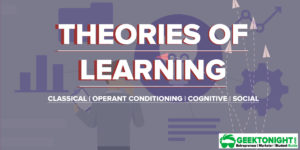What is Perception?
Perception is defined as the process by which an individual selects, organizes and interprets stimuli into a meaningful and coherent picture of the world.
It is a cognitive process by which people attend to incoming stimuli, organise and interpret such stimuli into behaviour.
Table of Content
- 1 What is Perception?
- 2 Perception Meaning
- 3 Perception Definition
- 4 Perception in Organisational Behavior
- 5 Nature of perception
- 6 Factors that Influence Perception
- 7 Managerial Implications of Perception
- 8 Implications of Perception on Performance and Satisfaction
- 9 Perception in Consumer Behavior
- 10 Perception Bias
- 11 Consumer Imagery
Stimulus is any unit of input to any of the senses; examples of stimuli (i.e. Sensory inputs) include products, packages, brand names; advertisement and commercials. Sensory receptors are the human organs (the eyes, ears, nose, mouth and skin) that receive sensory inputs. These sensory functions are to see, hear, smell, taste and feel respective.
The study of perception is largely the study of what we subconsciously add to or subtract from raw sensory inputs to produce a private picture of the world.
Sensation is the immediate and direct response of the sensory organs to simple stimuli and advertisement, a package, a brand name. Human sensitivity refers to the experiences of sensation.

Perception Meaning
The word Perception comes from the Latin words, “percipio” meaning “receiving, collecting, action of taking possession, apprehension with the mind or senses”.
Perception Definition
a process by which individuals organize and interpret their sensory impressions in order to give meaning to their environment
Stephen P. Robbins
Perception is an important meditative cognitive process through which persons make interpretations of the stimuli’s or situation they are faced with
Fred Luthans
Perception in Organisational Behavior
Why is perception important in the study of Organisational Behavior?
Simply because people’s behavior is based on their perception of what reality is, not on reality itself. The world as it is perceived is the world that is behaviorally important.
For example, in appraising performance, managers use their perceptions of an employee’s behaviour as a basis for evaluation. One work situation that highlights the importance of perception is the selection interview. Perception is also culturally determined. Based on our cultural backgrounds, we tend to perceive things in certain ways.
Read: What is Organizational Behavior?
Nature of perception
- Perception is the process by which an individual gives meaning to the environment.
- People‘s actions, emotions, thoughts and feelings are triggered by their perceptions of their surroundings.
- Perception has been defined in a variety of ways; it basically refers to the manner in which a person experiences the world.
- Perception is an almost automatic process and works in the same way within each individual, yet it typically yields different perceptions.
Read: Theories of Personality
Factors that Influence Perception
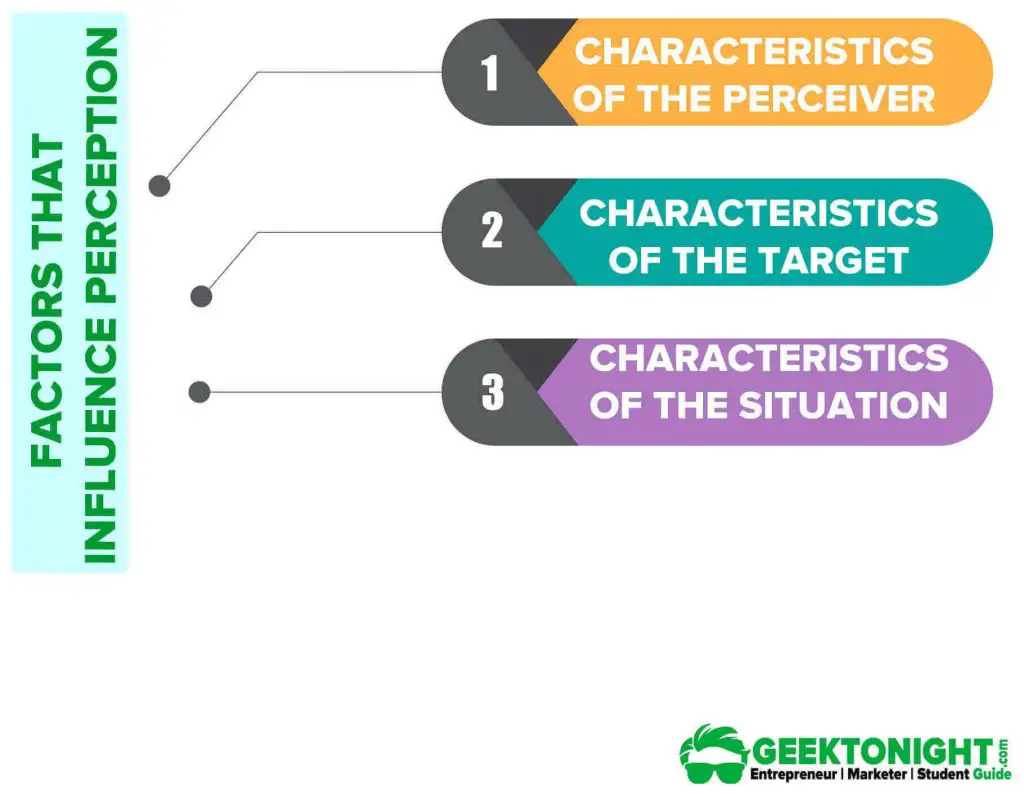
Characteristics of the Perceiver
Several characteristics of the perceiver can affect perception. When an individual looks at a target and attempts to interpret what he or she stands for, that interpretation is heavily influenced by personal characteristics of the individual perceiver.
The major characteristics of the perceiver influencing perception are:
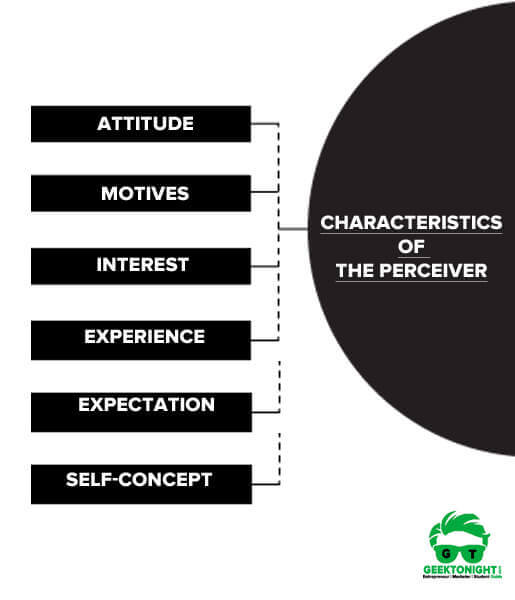
Attitude
The attitude and aptitude of employees influence perception formation. If they have positive attitudes towards the management, they directly perceive the stimuli given by management. In the case of negative attitudes, the employees suspect the management’s approach. Employees of high aptitude have a desire and attitude for growth. They behave positively toward the management of an organization.
Motives
The motives and desires of employees cause them to view stimuli differently as per their level and angle. Helpful motives of the employees will always assist the management. If they desire to develop themselves and the organization, they will perceive objects and situations positively. Employees having low motives will not work sincerely. The perception will differ depending on different types of motives.
Interest
The interest of individuals draws more attention and recognition to stimuli. Less attention and recognition lowers the impact of stimuli or objects on behaviour. If employees lack interest, behaviour pattern will be less effective, and the perception will be weak.
Experience
The experience of employees results in different levels of perception. A young employee takes time to understand the object and situation. Experienced employees generally understand objects quickly and correctly. However, in contradictory situations, it is difficult to correct aged persons, whereas the young are easily moulded towards achieving the objectives of the organization.
Expectation
Expectations distort perceptions. People see what they expect to see. If they see the object and the situation differently from their expectations, they get frustrated. They are unable to modify their behaviour. The employees may expect more pay and so they perceive the management from that angle. The real stimuli are not properly perceived if expectations exist there on. The management has to evolve expectations for proper perception.
Self-Concept
Another factor that can affect social perception is the perceivers’ selfconcept. An individual with a positive self-concept tends to notice positive attributes in another person. In contrast, a negative self-concept can lead a perceiver to pick out negative traits in another person. Greater understanding of self allows us to have more accurate perceptions of others.
Read: What is Learning?
Characteristics of the Target
Characteristics in the target that is being observed can affect what is perceived. Physical appearance plays a big role in our perception of others. Extremely attractive or unattractive individuals are more likely to be noticed in a group than ordinary looking individuals.
Motion, sound, size and other attributes of a target shape the way we see it.
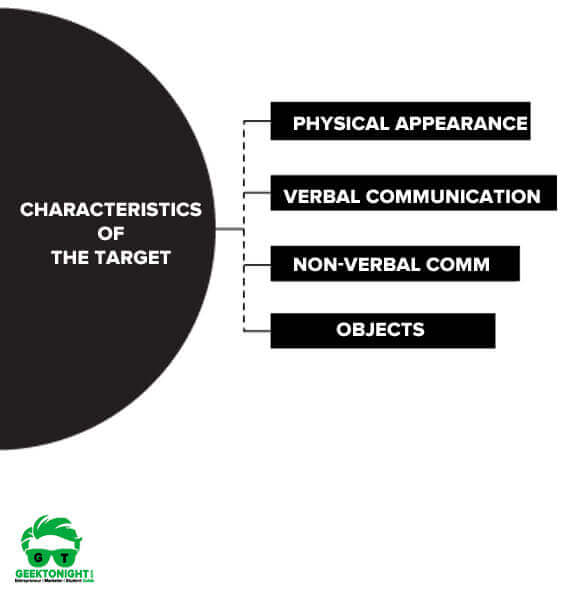
Physical appearance
Physical appearance plays a big role in our perception of others. The perceiver will notice the target’s physical features like height, weight, estimated age, race and gender. Perceivers tend to notice physical appearance characteristics that contrast with the norm, that are intense, or that are new or unusual.
Verbal communication
Verbal communication from targets also affects our perception of them. We listen to the topics they speak about, their voice tone, and their accent and make judgements based on this input.
Non-verbal communication
Non-verbal communication conveys a great deal of information about the target. The perceiver deciphers eye contact, facial expressions, body movements, and posture all in an attempt to form an impression of the target.
Targets are not looked at in isolation; the relationship of a target to its background influences perception because of our tendency to group close things and similar things together.
Objects
Objects that are close to each other will tend to be perceived together rather than separately. As a result of physical or time proximity, we often put together objects or events that are unrelated.
People, objects or events that are similar to each other also tend to be grouped together. The greater the similarity, the greater the probability we will tend to perceive them as a group.
Read: What is Attitude?
Characteristics of the Situation
Change in situation leads to incorrect perception about a person.
The factor that influence the perception are:
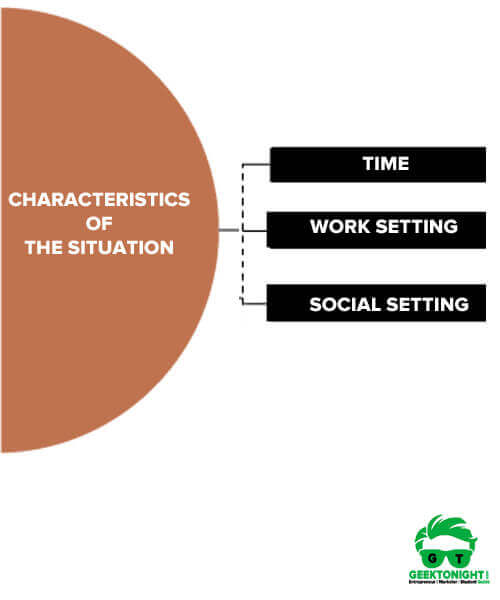
Time
The situation in which the interaction between the perceiver
and the target takes place has an influence on the perceiver’s impression of
the target.
For Example, a person decked up for a party may not be noticeable but the same dress in office would be noticed distinctly, though the person has not changed.
Work setting
You would have very frequently heard people say that their manager is different during working hours and 1800 opposite while in a social setting.
The strength of the situational cues also affects social perception. Some situations provide strong cues as to appropriate behaviour. In these situations, we assume that the individual’s behaviour can be accounted for by the situation and that it may not reflect the individual’s disposition. This is the discounting principle in social perception.
For example, you may encounter an automobile salesperson who has a warm and personable manner, asks you about your work and hobbies, and seems genuinely interested in your taste in cars. Can you assume that this behaviour reflects the salesperson’s personality? You probably cannot, because of the influence of the situation. This person is trying to sell you a car, and in this particular situation, he probably treats all customers in this manner.
Go to Section
What is Perception? | Perception Meaning | Perception Definition | Perception in Organisational Behavior | Nature of perception | Factors that Influence Perception | Importance of Perception | Perception in Consumer Behavior | Perception Bias
Managerial Implications of Perception
People in organisations are always judging each other. Managers must appraise their subordinate’s performance. Let us look at the more obvious applications of perceptions in organisations.
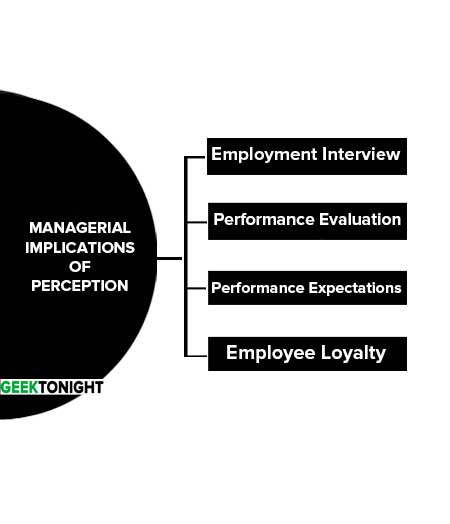
Employment Interview
A major input into who is hired and who is rejected in any organisation is the employment interview. Evidence indicates that interviewers often make inaccurate perceptual judgements. Interviewers generally draw early impressions that become very quickly entrenched.
Performance Evaluation
An employee’s performance appraisal very much depends on the perceptual process. The performance appraisal represents an assessment of an employee’s work. While this can be objective, many jobs are evaluated in subjective terms. Subjective measures are, by definition, judgemental.
Performance Expectations
A manager’s expectations of an individual affect both the manager’s behaviour towards the individual and the individual’s response.
Employee Loyalty
Another important judgement that managers make about employees is whether they are loyal to the organisation. Few organisations appreciate employees, especially those in the managerial ranks openly disparaging the firm.
Perception is an important process in an organisation. It plays a vital role in forming the basis of one’s behaviour by which one formulates a view of the world.
Implications of Perception on Performance and Satisfaction
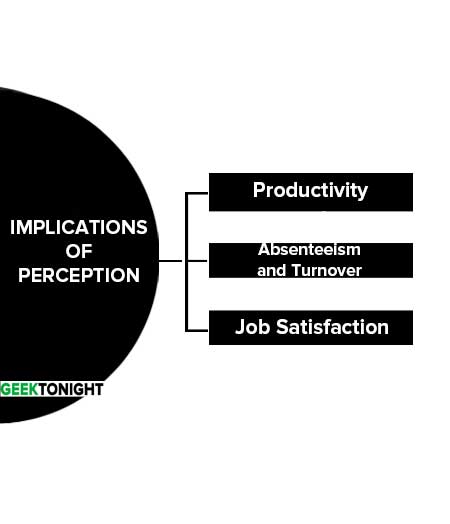
Productivity
What individuals perceive from their work situation will influence their productivity. More than the situation itself than whether a job is actually interesting or challenging is not relevant. How a manager successfully plans and organizes the work of his subordinates and actually helps them in structuring their work is far less important than how his subordinates perceive his efforts. Therefore, to be abl
Absenteeism and Turnover
Absence and Turnover are some of the reactions to the individual’s perception. Managers must understand how each individual interprets his job. and where there is a significant difference between what is seen and what exists and try to eliminate the distortions.
Job Satisfaction
Job satisfaction is a highly subjective, and feeling of the benefits that derive from the job. Clearly his variable is critically linked to perception. Clearly his variable is critically linked to perception. If job satisfaction is to be improved, the worker’s perception of the job characteristics, supervision and the organisation as a whole must be positive.
Read: What is Motivation?
Perception in Consumer Behavior
Different Perceptions of Consumers: People can emerge with different perceptions of the same object because of these perceptual processes
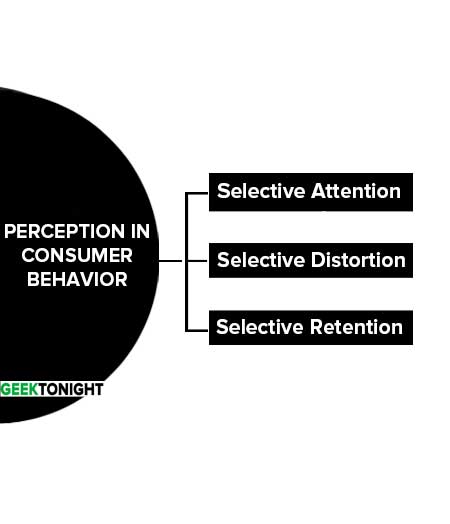
Selective Attention
People are exposed to a huge amount of daily stimuli in the form of advertisement but a person cannot possibly give attention to all the advertisements.
Most of the advertisements (stimuli) are screened out. A person perceives only that stimulus (ad of the product) which he needs or which have a unique selling proposition. People would like to notice the following types of stimuli:
- People are more likely to notice stimuli that relate to the current need.
- People are more likely to notice stimuli that they anticipate.
- People are more likely to notice stimuli whose deviations are large in relation to the normal size of stimuli. Ads that are larger in size or that use four colours or are novel and provide contrast are more likely to be noticed.
People differ in terms of the kind of information they prefer. They also have varying preference for media. Some are more interested in appearance, some in social prestige and some in price. Some prefer elaborate ads where as some like simple messages. Consumers show wide variation in their selective attention to commercial stimuli.
Selective Distortion
It describes the tendency of people to twist information into personal meaning. People interpret information in a way that will support rather than challenge their preconceptions.
Selective Retention
People tend to retain information that supports their attitudes and beliefs (selective retention). It has been found that consumers are much more likely to recall seeing advertisements of those brands that they are using or want to use.
Because of these perceptual factors (selective attention, selective distortion, selective retention), marketers use drama and repetition in sending messages to their target market.
Perception Bias
Below are the list of 6 perception bias:
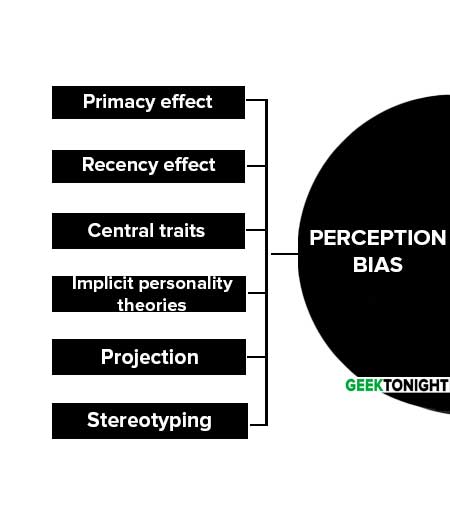
Primacy effect
The tendency for a perceiver to rely on early cues or first impressions.
Recency effect
The tendency for a perceiver to rely on recent cues or last impressions.
Central traits
Personal characteristics of a target person that are of particular interest to a perceiver
Implicit personality theories
Personal theories that people have about which personality characteristics go together.
Projection
The tendency for perceivers to attribute their own thoughts and feelings to others.
Stereotyping
The tendency to generalize about people in a certain social category and ignore variations among them.
Consumer Imagery
An image is a total perception of something that individuals form by processing all the information they are exposed to over time. Research indicates that consumers develop enduring perceptions or images about brands, prices, stores and companies. These inferences are consumers’ beliefs about products or services.
Consumers may associate an Omega or Rolex watch with quality because of their advertising or word-of-mouth communications from friends. Individuals develop a self-image of themselves and certain brands carry a symbolic value for them. Some products seem to match this self-image of an individual while others do not.
According to Russell W Belk, consumers attempt to enhance or preserve their self-images by purchasing products that they believe correspond to or agree with their self-images and avoid buying products that do not fit their self-images.
Consumers also tend to buy from those outlets that seem to be consistent with their self-image. Many large retail stores and chains in India have started focusing on the need to build their identity to attract certain classes of consumers and create store loyalty among them.
Read Complete: Consumer Imagery
Go to Section:
What is Perception? | Perception Meaning | Perception Definition | Perception in Organisational Behavior | Nature of perception | Factors that Influence Perception | Importance of Perception | Perception in Consumer Behavior | Perception Bias
Reference
- Robbins, Stephen P. 2010. Organizational Behaviour. New Delhi, Prentice-Hall.
- Furnham, A. (1997). The Psychology of Behaviour at Work. Sussex: Taylor & Francis.
- Zalkind, S.S. and Costello, T.W. (1962). Perception: Some Recent Research and Implications for Administration. Administrative Science Quarterly, 7,218-235.
Go On, Share & Help your Friend
Did we miss something in Organizational Behavior Tutorial or You want something More? Come on! Tell us what you think about our post on Perception, Definition, Nature, Factors Influence Perception| Organisational Behavior in the comments section and Share this post with your friends.
Marketing Management
(Click on Topic to Read)
- What Is Market Segmentation?
- What Is Marketing Mix?
- Marketing Concept
- Marketing Management Process
- What Is Marketing Environment?
- What Is Consumer Behaviour?
- Business Buyer Behaviour
- Demand Forecasting
- 7 Stages Of New Product Development
- Methods Of Pricing
- What Is Public Relations?
- What Is Marketing Management?
- What Is Sales Promotion?
- Types Of Sales Promotion
- Techniques Of Sales Promotion
- What Is Personal Selling?
- What Is Advertising?
- Market Entry Strategy
- What Is Marketing Planning?
- Segmentation Targeting And Positioning
- Brand Building Process
- Kotler Five Product Level Model
- Classification Of Products
- Types Of Logistics
- What Is Consumer Research?
- What Is DAGMAR?
- Consumer Behaviour Models
- What Is Green Marketing?
- What Is Electronic Commerce?
- Agricultural Cooperative Marketing
- What Is Marketing Control?
- What Is Marketing Communication?
- What Is Pricing?
- Models Of Communication
Sales Management
- What is Sales Management?
- Objectives of Sales Management
- Responsibilities and Skills of Sales Manager
- Theories of Personal Selling
- What is Sales Forecasting?
- Methods of Sales Forecasting
- Purpose of Sales Budgeting
- Methods of Sales Budgeting
- Types of Sales Budgeting
- Sales Budgeting Process
- What is Sales Quotas?
- What is Selling by Objectives (SBO)?
- What is Sales Organisation?
- Types of Sales Force Structure
- Recruiting and Selecting Sales Personnel
- Training and Development of Salesforce
- Compensating the Sales Force
- Time and Territory Management
- What Is Logistics?
- What Is Logistics System?
- Technologies in Logistics
- What Is Distribution Management?
- What Is Marketing Intermediaries?
- Conventional Distribution System
- Functions of Distribution Channels
- What is Channel Design?
- Types of Wholesalers and Retailers
- What is Vertical Marketing Systems?
Marketing Essentials
- What is Marketing?
- What is A BCG Matrix?
- 5 M'S Of Advertising
- What is Direct Marketing?
- Marketing Mix For Services
- What Market Intelligence System?
- What is Trade Union?
- What Is International Marketing?
- World Trade Organization (WTO)
- What is International Marketing Research?
- What is Exporting?
- What is Licensing?
- What is Franchising?
- What is Joint Venture?
- What is Turnkey Projects?
- What is Management Contracts?
- What is Foreign Direct Investment?
- Factors That Influence Entry Mode Choice In Foreign Markets
- What is Price Escalations?
- What is Transfer Pricing?
- Integrated Marketing Communication (IMC)
- What is Promotion Mix?
- Factors Affecting Promotion Mix
- Functions & Role Of Advertising
- What is Database Marketing?
- What is Advertising Budget?
- What is Advertising Agency?
- What is Market Intelligence?
- What is Industrial Marketing?
- What is Customer Value
Consumer Behaviour
- What is Consumer Behaviour?
- What Is Personality?
- What Is Perception?
- What Is Learning?
- What Is Attitude?
- What Is Motivation?
- Segmentation Targeting And Positioning
- What Is Consumer Research?
- Consumer Imagery
- Consumer Attitude Formation
- What Is Culture?
- Consumer Decision Making Process
- Consumer Behaviour Models
- Applications of Consumer Behaviour in Marketing
- Motivational Research
- Theoretical Approaches to Study of Consumer Behaviour
- Consumer Involvement
- Consumer Lifestyle
- Theories of Personality
- Outlet Selection
- Organizational Buying Behaviour
- Reference Groups
- Consumer Protection Act, 1986
- Diffusion of Innovation
- Opinion Leaders
Business Communication
- What is Business Communication?
- What is Communication?
- Types of Communication
- 7 C of Communication
- Barriers To Business Communication
- Oral Communication
- Types Of Non Verbal Communication
- What is Written Communication?
- What are Soft Skills?
- Interpersonal vs Intrapersonal communication
- Barriers to Communication
- Importance of Communication Skills
- Listening in Communication
- Causes of Miscommunication
- What is Johari Window?
- What is Presentation?
- Communication Styles
- Channels of Communication
- Hofstede’s Dimensions of Cultural Differences and Benett’s Stages of Intercultural Sensitivity
- Organisational Communication
- Horizontal Communication
- Grapevine Communication
- Downward Communication
- Verbal Communication Skills
- Upward Communication
- Flow of Communication
- What is Emotional Intelligence?
- What is Public Speaking?
- Upward vs Downward Communication
- Internal vs External Communication
- What is Group Discussion?
- What is Interview?
- What is Negotiation?
- What is Digital Communication?
- What is Letter Writing?
- Resume and Covering Letter
- What is Report Writing?
- What is Business Meeting?
- What is Public Relations?
Business Law
- What is Business Law?
- Indian Contract Act 1872
- Essential Elements of a Valid Contract
- Types of Contract
- What is Discharge of Contract?
- Performance of Contract
- Sales of Goods Act 1930
- Goods & Price: Contract of Sale
- Conditions and Warranties
- Doctrine of Caveat Emptor
- Transfer of Property
- Rights of Unpaid Seller
- Negotiable Instruments Act 1881
- Types of Negotiable Instruments
- Types of Endorsement
- What is Promissory Note?
- What is Cheque?
- What is Crossing of Cheque?
- What is Bill of Exchange?
- What is Offer?
- Limited Liability Partnership Act 2008
- Memorandum of Association
- Articles of Association
- What is Director?
- Trade Unions Act, 1926
- Industrial Disputes Act 1947
- Employee State Insurance Act 1948
- Payment of Wages Act 1936
- Payment of Bonus Act 1965
- Labour Law in India
Brand Management
Human Resources Tutorial
(Click on Topic to Read)


